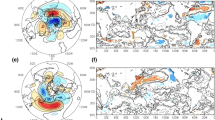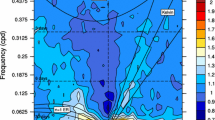Abstract
The ability of 15 atmospheric general circulation models (AGCM) to simulate the tropical intraseasonal oscillation has been studied as part of the Atmospheric Model Intercomparison Project (AMIP). Time series of the daily upper tropospheric velocity poential and zonal wind, averaged over the equatorial belt, were provided from each AGCM simulation. These data were analyzed using a variety of techniques such as time filtering and space-time spectral analysis to identify eastward and westward moving waves. The results have been compared with an identical assessment of the European Centre for Medium-range Weather Forecasts (ECMWF) analyses for the period 1982–1991. The models display a wide range of skill in simulating the intraseasonal oscillation. Most models show evidence of an eastward propagating anomaly in the velocity potential field, although in some models there is a greater tendency for a standing oscillation, and in one or two the field is rather chaotic with no preferred direction of propagation. Where a model has a clear eastward propagating signal, typical periodicities seem quite reasonable although there is a tendency for the models to simulate shorter periods than in the ECMWF analyses, where it is near 50 days. The results of the space-time spectral analysis have shown that no model has captured the dominance of the intraseasonal oscillation found in the analyses. Several models have peaks at intraseasonal time scales, but nearly all have relatively more power at higher frequencies (< 30 days) than the analyses. Most models underestimate the strength of the intraseasonal variability. The observed intraseasonal oscillation shows a marked seasonality in its occurrence with greatest activity during northern winter and spring. Most models failed to capture this seasonality. The interannual variability in the activity of the intraseasonal oscillation has also been assessed, although the AMIP decade is too short to provide any conclusive results. There is a suggestion that the observed oscillation was suppressed during the strong El Niño of 1982/83, and this relationship has also been reproduced by some models. The relationship between a model's intraseasonal activity, its seasonal cycle and characteristics of its basic climate has been examined. It is clear that those models with weak intraseasonal activity tend also to have a weak seasonal cycle. It is becoming increasingly evident that an accurate description of the basic climate may be a prerequisite for producing a realistic intraseasonal oscillation. In particular, models with the most realistic intraseasonal oscillations appear to have precipitation distributions which are better correlated with warm sea surface temperatures. These models predominantly employ convective parameterizations which are closed on buoyancy rather than moisture convergence.
Similar content being viewed by others
References
Bladé I, Hartmann DL (1993) Tropical intraseasonal oscillations in a simple nonlinear model. J Atmos Sci 50:2922–2939
Ferranti L, Palmer TN, Molteni F, Klinker E (1990) Tropical-extratropical interaction associated with the 30–60 day oscillation and its impact on medium and extended range prediction. J Atmos Sci 47:2177–2199
Gates WL (1992) AMIP: The Atmospheric Model Intercomparison Project. Bull Am Meteorol Soc 73:1962–1970
Gray BM (1988) Seasonal frequency variations in the 40–50 day oscillation. Int J Climatol 8:511–519
Hayashi Y (1982) Space-time spectral analysis and its application to atmospheric waves. J Meteorol Soc Japan 60:156–171
Hayashi Y, Golder DG (1993) Tropical 40–50- and 25–30-day oscillations appearing in realistic and idealized GFDL climate models and the ECMWF dataset. J Atmos Sci 50:464–494
Hendon HH, Liebmann B (1994) Organization of convection within the Madden-Julian oscillation. J Geophys Res 99:8073–8083
Hendon HH, Salby ML (1994) The life cycle of the Madden-Julian oscillation. J Atmos Sci 51:2225–2237
Hess PG, Battisti DS, Rasch PJ (1993) The maintenance of the intertropical convergence zones and the large-scale tropical circulation on a water-covered earth. J Atmos Sci 50:691–713
Hoskins BJ, Hsu HH, James IN, Masutani M, Sardeshmukh PD, White GH (1989) Diagnostics of the global atmospheric circulation based on ECMWF analyses 1979–1989 WCRP-27. World Meteorological Organization, Geneva
Hsu H, Hoskins BJ, Jin F (1990) The 1985/86 intraseasonal oscillation and the role of the extratropics. J Atmos Sci 47:823–839
Kiladis GN, Weickmann KM (1992) Circulation anomalies associated with tropical convection during northern winter. Mon Weather Rev 120:1900–1923
Knutson TR, Weickmann KM (1987) 30–60 day atmospheric oscillations: composite life cycles of convection and circulation anomalies. Mon Weather Rev 115:1407–1436
Kuhnel I (1989) Spatial and temporal variation in Australia-Indonesia region cloudiness. Int J Climatol 9:395–405
Lander J (1994) The interaction of numerics and physics in a spectral transform GCM. PhD Thesis, Department of Meteorology, Reading University, Reading, UK
Lau K-M, Chan PH (1985) Aspects of the 40–50 day oscillation during the northern winter as inferred from outgoing longwave radiation. Mon Weather Rev 113:1889–1909
Lau K-M, Chan PH (1988) Interannual and intraseasonal variations of tropical convection: a possible link between the 40–50 day oscillation and ENSO? J Atmos Sci 44:506–521
Lau K-M, Held IM, Neelin JD (1988) The Madden-Julian oscillation in an idealized general circulation model. J Atmos Sci 45:3810–3832
Lau K-M, Peng L, Sui CH, Nakazawa T (1989) Dynamics of super cloud clusters, westerly wind bursts, 30–60 day oscillations and ENSO: a unified view. J Meteorol Soc Japan 67:205–219
Lau K-M, Nakazawa T, Sui CH (1991) Observations of cloud cluster hierarchies over the tropical western Pacific. J Geophys Res 96:3197–3208
Lim H, Chang C-P, Lim T-K (1991) Vertical wind shear effects on Kelvin wave-CISK modes: possible relevance to 30–60 day oscillations. Terrest Atmos Oceanic Sci 2:203–216
Madden RA, Julian PR (1972) Description of global scale circulation cells in the tropics with 40–50 day period. J Atmos Sci 29:1109–1123
Madden RA, Julian PR (1994) Observations of the 40–50-day tropical oscillation — a review. Mon Weather Rev 122:814–837
Magaña V (1993) The 40- and 50-day oscillations in atmospheric angular momentum at various latitudes. J Geophys Res 98:10441–10450
Matthews AJ (1994) The intraseasonal oscillation. PhD Thesis, Department of Meteorology, University of Reading, Reading, UK
Murakami T, Chen L-X, Xie A, Shrestha ML (1986) Eastward propagation of 30–60 day perturbations as revealed from outgoing longwave radiation data. J Atmos Sci 43:961–971
Nakazawa T (1988) Tropical super clusters within intraseasonal variations over the western Pacific. J Meteorol Soc Japan 66:823–839
Park C-K, Straus DM, Lau K-M (1990) An evaluation of the structure of tropical intraseasonal oscillations in three general circulation models. J Meteorol Soc Japan 68:403–417
Phillips TJ (1994) A summary documentation of the AMIP models. PCMDI Rep 18, PCMDI, Lawrence Livermore National Laboratory, California
Rasmusson EM, Mo K (1993) Linkages between 200-mb tropical and extratropical circulation anomalies during the 1986–89 ENSO cycle. J Clim 6:595–616
Riehl H (1954) Tropical meteorology. McGraw-Hill, New York
Rosen RD, Salstein DA (1983) Variations in atmospheric angular momentum on global and regional scales and the length of day. J Geophys Res 88:5451–5470
Rui H, Wang B (1990) Development characteristics and dynamic structure of tropical intraseasonal convection anomalies. J Atmos Sci 47:357–379
Salby ML, Hendon HH (1994) Intraseasonal behavior of clouds, temperature and motion in the tropics. J Atmos Sci 51:2207–2224
Salby ML, Garcia RR, Hendon HH (1994) Planetary-scale circulations in the presence of climatological and wave-induced heating. J Atmos Sci 51:2344–2367
Sardeshmukh PD, Hoskins BJ (1988) The generation of global rotational flow by steady idealized tropical convergence. J Atmos Sci 45:1228–1251
Slingo JM, Madden RA (1991) Characteristics of the tropical intraseasonal oscillation in the NCAR Community Climate Model. QJR Meteorol Soc 117:1129–1169
Slingo JM, Sperber KR, Morcrette J-J, Potter GL (1992) Analysis of the temporal behavior of convection in the tropics of the ECMWF model. J Geophys Res 97:18119–18135
Slingo JM, Blackburn M, Betts A, Brugge R, Hoskins BJ, Miller MJ, Steenman-Clark L, Thuburn J (1994) Mean climate and transience in the tropics of the UGAMP GCM: sensitivity to convective parameterization. QJR Meteorol Soc 120:881–922
Slingo JM, Sperber KR, Boyle JS, Ceron J-P, Dix M, Dugas B, Ebisuzaki W, Fyfe J, Gregory D, Gueremy J-F, Hack J, Harzallah A, Inness P, Kitch A, Lau WK-M, McAvaney B, Madden R, Matthews A, Palmer TN, Park C-K, Randall D, Renno N (1995) Intraseasonal oscillations in 15 atmospheric general circulation models (results from an AMIP Diagnostic Subproject). WCRP-88, WMO/TD-No. 661, WMO, Geneva
Spencer RW (1993) Global oceanic precipitation from the MSU during 1979–91 and comparison to other climatologies. J Clim 6:1301–1326
Sumi A (1992) Pattern formation of convective activity over the Aqua Planet with globally uniform sea surface temperature. J Meteorol Soc Japan 70:855–876
Takayabu YN (1994) Large scale cloud disturbances associated with equatorial waves. Part I: spectral features of the cloud disturbances. J Meteorol Soc Japan 72:433–450
Webster P, Lukas R (1992) TOGA COARE: The coupled oceanatmosphere response experiment. Bull Am Meteorol Soc 73:1377–1416
Weickmann KM, Khalsa SJS (1990) The shift of convection from the Indian Ocean to the western Pacific Ocean during a 30–60 day oscillation. Mon Weather Rev 118:964–978
Author information
Authors and Affiliations
Rights and permissions
About this article
Cite this article
Slingo, J.M., Sperber, K.R., Boyle, J.S. et al. Intraseasonal oscillations in 15 atmospheric general circulation models: results from an AMIP diagnostic subproject. Climate Dynamics 12, 325–357 (1996). https://doi.org/10.1007/BF00231106
Received:
Accepted:
Issue Date:
DOI: https://doi.org/10.1007/BF00231106




